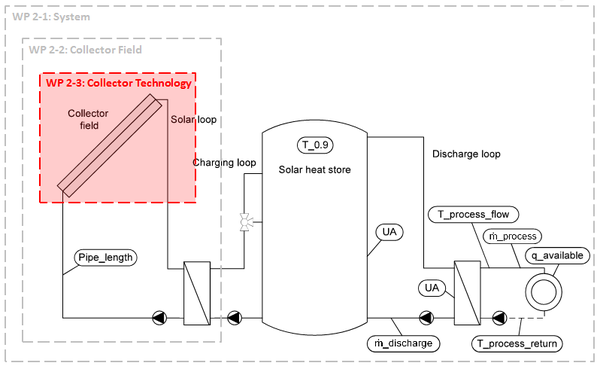WP2-3 Development of a methodology for the quick assessment and comparison of process heat collectors and systems
Supervisor(s)
Hosted by: | University of Balearic Islands |
|---|---|
Student: | Julian Hertel |
Started: | 01/05/2014 |
Supervisor(s): | Prof. Victor Martínez Moll (UIB) Dr. Ramon Pujol (UIB) |
Short description
The Construction Engineering and Energy Management group of the University of the Balearic Islands has been involved for the last six years in the development and testing of the CCStaR collector, a fixed mirror concentrating collector designed to work in the range of 100ºC to 200ºC. At this moment the focus of the project has shifted from design and preliminary assessment to full characterization and assessment of the technology. In this framework the tasks to be performed during the PhD will be related mainly to the development of proper assessment methods for annual yields, taking into account different acceptance angles and IAM curves.

The industry sector with its high and constant energy demand shows a remarkable potential for the integration of solar thermal technologies, yet, industrial processes nowadays still rely on conventional energy supply. Even though, in many cases the exploitation of available solar resources is economically well feasible and profitable, the fear of unreliability and unpredictability often associated with solar energy, keeps companies from new investments in supplementary facilities. Moreover, the site specific requirements of industrial customers to solar technologies has led to a vast variety of collector designs, which made it difficult to be characterized by traditional collector testing standards.
In order to help authorities with the decision-making process, a tool would be desirable that allows to quickly assess the economic potential of a specific collector at specific sites at a minimum cost of engineering resources. First attempts to develop such a tool were already made with the energy output softwares ScenoCalc and GainBuddy (developed by SPF, Switzerland) both of which are based on the Quasi-Dynamic-Testing Method and are currently in the testing phase. One of the key challenges it will be to design the program in such a way as to make it compatible with the vast majority of possible collector designs.
On the one hand in-situ measurements combining thermal efficiency analysis with photogrammetry and ray tracing methods will be carried out in order to fully characterize the optical and thermal behavior of the collector. On the other hand an extensive simulation program will be conducted, to obtain the integrated energy yield of different collector designs, under different climatic, geographic and working conditions. The output of that simulation program will be used to establish simple comparison procedures based on the energy output of the different designs. The model can be extended to compare not only the collector technologies but also complete systems. The used methodologies will include numerical simulations, script programming in Python / numpy, statistical analysis and data fitting.
Numerical Tools:
• OTSun (In-house ray tracing software)
• VariCAD CAD editor
• Python 2.7.6
• Meteonorm (Weather data base)
Achieved milestones:
The main objective of the thesis is to develop a simulation program whose final output will be an intuitive graphical representation of the solar collector´s energy output. During the development of the program there are a couple of mathematical models whose generality regarding different collector designs need to be tested. Most of these models proved to be accurate in their respective fields (the low temperature sector or high temperature sector), but might not be applicable to adapted medium temperature designs.
1. Factorization Approximation for Biaxial Incidence Angle Modifiers (IAM):
As the geometry becomes complex, collectors show also more a complex response to radiation of different angles of incidence. To derive missing IAM values for specific angles of incidence from a limited set of experimental test points, the factorization approach suggested by McIntire was applied. During the years adaptations of the original approach were suggested, which led to different interpretations of how the factorization should be carried out. Since very little was known about the actual impact of different definitions on the error of estimation, it was found to be necessary to carry out a more extensive study with the aim of establishing a cross-technological consensus of which definition to use. The study was published in (Hertel et al., 2015b). A related study was conducted to analyse the thermal dependency of the IAM factorization error. It is currently under revision in (Hertel et al., 2015a).
2. Efficiency curve extrapolation
Starting from a set of experimentally defined points, the efficiency curve of a collector is commonly extended to higher temperature ranges by extrapolation. This technique usually underestimates the stagnation point of the curve. A preliminary study was conducted and presented at the Solar World Congress 2015 (Hertel et al., 2015c). High temperature measurements were planned to be carried out in order to test the reliability of efficiency curve extrapolation.
3. Ray tracing sensitivity analysis and validation
Nowadays ray tracing programs are a very commonly used tool for the optical characterization of concentrating solar collectors. Not only are they irreplaceable for designing and optimizing conventional or even completely new collector concepts, they also allow to economically determine the error tolerance margins for real operating collectors or they could serve to complement testing procedures where laboratory settings cannot reproduce real conditions. Apart from these most common applications, optical modelling might gain even more importance with the increasing success of PV and PVT applications.
This milestone will consist in analysing the influence of different optical models on the overall simulation result. For that purpose, in a first step, a literature research was conducted to determine the most important and mostly applied radiation-matter interaction models. An abstract of the results of this pre-study was submitted to the EuroSun2016 and will be presented there (Hertel et al., 2016). Based on these results all relevant models (most of all models of coatings) will be implemented in our FORTRAN in-house ray tracing tool. In a next step, a sensitivity analysis will be conducted and finally validated with simple experimental setups.
